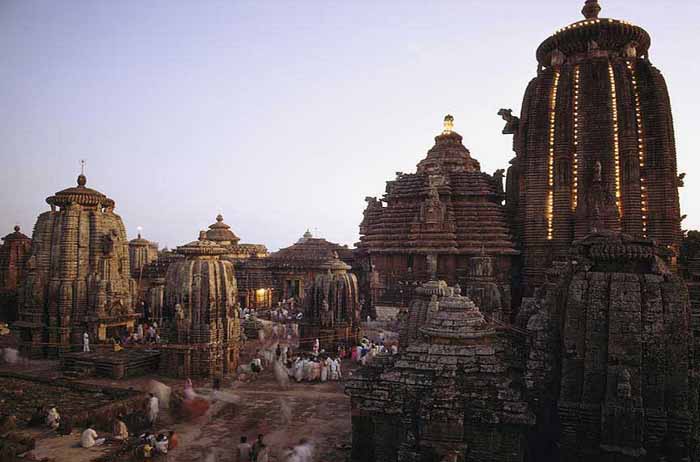Lingaraj Temple

Information of Lingaraj Temple, Bhubaneswar, Odisha
The Lingaraj temple forms an important part of the city of Bhubaneswar and also adds greatly to the tourism. Its exact location is in the Khurda district in Bhubaneswar in the Indian state of Orissa now changed to Odisha. It is a Hindu temple and is dedicated to Lingaraj another name given to Lord Shiva. Lord Shiva is referred to as Harihara and his consort Goddess Parvati as Bhuvaneshvari.
Lingaraj Temple Religious Significance
The main deity of the temple is in the form of a Lingam that belongs to Lord Shiva. Worshipping Lord Shiva in the form of Lingam is a common practise in the Saiviam sect of Hinduism. The deity is also worshipped as Lord Visha therefore a blend worshipping of both the sects of Hinduism is seen in the temple. The main festival celebrated in the temple is Shivaraatri where devotees of Lord Shiva stay awake all night singing his glories and offering prayers. The Lingam is daily offered with water a number of times and decorated with flowers, sandal pastes and tulsi leaves. Hemlock flowers are not allowed to be offered in the temple. Another festival celebrated is the rath yatra where the main deity is carried in a chariot decorated beautifully to the Rameshwar Deula temple.
The Lingaraja temple is open for worship at 6 am in the morning and closed at 9 pm at night with a short interval of closure during the day to offer food to the Lingam. A mixture of milkcurd, butter, ghee and honey is offered to the Lord. The Lingaraja temple is and active complex of worship in Bhubaneswar and is most crowded during Shiva raatri. Entries of non Hindus are strictly prohibited inside the temple. The average number of devotes visiting the temple is around 6000 and around lakhs of people visiting during festivals.
Lingaraj Temple Mythology & History
Lord Shiva is worshipped in different forms and in this temple is worshipped as Lingaraj that is the King of Lingams. He is considered as the ruler of the three world's heaven, earth and netherworld.
The Lingaraja temple just like many other temples of Bhubaneswar has different theories about the period of construction of the temple ranging from 6th century to 12th century. However it strongly believed that the present structure was built by King Jajati Keshari of the Somavanshi dynasty in the 11th century. A queen of the Somavanshi dynasty donated a village to construct a temple and also offered gold coins. They were ardent devotee of Lord Shiva. It is said that the idol of Lingaraj was originally installed under a mango tree as written in the Ekrama Purana. There is underground water feeding a tank under the temple of Lingaraj. According to Hindu legend a dip in the Bindusagar tank is considered holy and spiritually and physically healing.
Lingaraj Temple Architectural Significance
The Lingaraj Temple is one of the finest examples of Kalinga Architecture and built in the Deula style. It is made up of sandstone and laterite and consists of four major divisions as the vimana, jagamohana, natamandira and bhogamandapa in increasing heights. The temple faces towards the east. The vimana is a square hall and consists of the sanctum sanctorum and has a notable Shiva Lingam made up of Black stone. It comprises of a 55 metres tired spire which is carved with figures of Gods and Goddesess. Next to the vimana is the jagamohana or the hall of offering. It has a height of 30 metres and a hall measuring 11 metres by 9.1 metres. It has a pyramidal shaped roof made up of a number of tiers. The entrances are decorated with lions, bells and golden vase. Next to it lays the natamandira which is the festival hall. It measures an area of 12 metres by 38 metres from the interior side. It hall is decorated with sculptures of couples and women. It roof is flat with just a little slope. Lastly is the bhogamandapa which is the hall of offering. It is a square hall covering an area of 13 metres by 13 metres from the interior. The wall of the hall is decorated with carvings of men and beasts. It has a pyramidal roof as well with many layers of tiers.
The entire temple complex covers an area of 160 metres by 142 metres and is protected by a wall of 2.3 metres thickness. There are a total of 150 smaller shrines holding different deities of the Hindus. The from architectural point of view, the temple is well organised and well planned with several deities at one place and well planned to place them in different location making it easier and convenient for devotees for a visit. Here in this temple, everyone is welcome to offer prayer and seek blessing for joyful and prosperous life.
- Andhra Pradesh Temples
- Assam Temples
- Bihar Temples
- New Delhi Temples
- Goa Temples
- Gujarat Temples
- Jammu and Kashmir Temples
- Karnataka Temples
- Kerala Temples
- Madhya Pradesh Temples
- Maharashtra Temples
- Odisha Temples
- Punjab Temples
- Rajasthan Temples
- Sikkim Temples
- Tamil Nadu Temples
- Telangana Temples
- Uttar Pradesh Temples
- Uttarakhand Temples
- West Bengal Temples